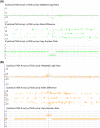Rare copy number variants in the genome of Chinese female children and adolescents with Turner syndrome
- PMID: 30530863
- PMCID: PMC6328875
- DOI: 10.1042/BSR20181305
Rare copy number variants in the genome of Chinese female children and adolescents with Turner syndrome
Abstract
Turner syndrome (TS) is a congenital disease caused by complete or partial loss of one X chromosome. Low bone mineral status is a major phenotypic characteristic of TS that can not be fully explained by X chromosome loss, suggesting other autosomal-linked mutations may also exist. Therefore, the present study aimed to detect potential genetic mutations in TS through examination of copy number variation (CNV). Seventeen patients with TS and 15 healthy volunteer girls were recruited. Array-based comparative genomic hybridization (a-CGH) was performed on whole blood genomic DNA (gDMA) from the 17 TS patients and 15 healthy volunteer girls to identify potential CNVs. The abnormal CNV of one identified gene (CARD11) was verified by quantitative PCR. All cases diagnosed had TS based on genotype examination and physical characteristics, including short stature and premature ovarian failure. Three rare CNVs, located individually at 7p22.3, 7p22.2, and Xp22.33, where six genes (TTYH3, AMZ1, GNA12, BC038729, CARD11, and SHOX (stature homeobox)) are located, were found in TS patients. Quantitative PCR confirmed the CNV of CARD11 in the genome of TS patients. Our results indicate that CARD11 gene is one of the mutated genes involved in TS disease. However, this CNV is rare and its contribution to TS phenotype requires further study.
Keywords: CARD11 gene; Turner Syndrome; bone mineral status; copy number variation.
© 2019 The Author(s).
Conflict of interest statement
The authors declare that there are no competing interests associated with the manuscript.
Figures



Similar articles
-
Gene dosage as a relevant mechanism contributing to the determination of ovarian function in Turner syndrome.Hum Reprod. 2014 Feb;29(2):368-79. doi: 10.1093/humrep/det436. Epub 2013 Dec 8. Hum Reprod. 2014. PMID: 24324027 Free PMC article.
-
Higher CNV Frequencies in Chromosome 14 of Girls With Turner Syndrome Phenotype.J Clin Endocrinol Metab. 2021 Nov 19;106(12):e4935-e4955. doi: 10.1210/clinem/dgab572. J Clin Endocrinol Metab. 2021. PMID: 34333639
-
Autosomal and X chromosome structural variants are associated with congenital heart defects in Turner syndrome: The NHLBI GenTAC registry.Am J Med Genet A. 2016 Dec;170(12):3157-3164. doi: 10.1002/ajmg.a.37953. Epub 2016 Sep 8. Am J Med Genet A. 2016. PMID: 27604636 Free PMC article.
-
The role of the SHOX gene in the pathophysiology of Turner syndrome.Endocrinol Nutr. 2011 Oct;58(8):433-42. doi: 10.1016/j.endonu.2011.06.005. Epub 2011 Sep 16. Endocrinol Nutr. 2011. PMID: 21925981 Review.
-
The contribution of Xp22.31 gene dosage to Turner and Klinefelter syndromes and sex-biased phenotypes.Eur J Med Genet. 2021 Apr;64(4):104169. doi: 10.1016/j.ejmg.2021.104169. Epub 2021 Feb 19. Eur J Med Genet. 2021. PMID: 33610733 Review.
Cited by
-
Effect of Hormone Replacement Therapy on Bone Mineral Density and Body Composition in Chinese Adolescent and Young Adult Turner Syndrome Patients.Front Endocrinol (Lausanne). 2019 Jun 12;10:377. doi: 10.3389/fendo.2019.00377. eCollection 2019. Front Endocrinol (Lausanne). 2019. PMID: 31244781 Free PMC article.
-
Capacitive interdigitated system of high osteoinductive/conductive performance for personalized acting-sensing implants.NPJ Regen Med. 2021 Nov 23;6(1):80. doi: 10.1038/s41536-021-00184-6. NPJ Regen Med. 2021. PMID: 34815414 Free PMC article.
-
Genome-wide Mendelian randomization identifies drugs associated with body height.Transl Pediatr. 2024 Nov 30;13(11):1959-1971. doi: 10.21037/tp-24-265. Epub 2024 Nov 26. Transl Pediatr. 2024. PMID: 39649642 Free PMC article.
-
DNA Hypermethylation and a Specific Methylation Spectrum on the X Chromosome in Turner Syndrome as Determined by Nanopore Sequencing.J Pers Med. 2022 May 26;12(6):872. doi: 10.3390/jpm12060872. J Pers Med. 2022. PMID: 35743657 Free PMC article.
-
The tweety Gene Family: From Embryo to Disease.Front Mol Neurosci. 2021 Jun 28;14:672511. doi: 10.3389/fnmol.2021.672511. eCollection 2021. Front Mol Neurosci. 2021. PMID: 34262434 Free PMC article.
References
Publication types
MeSH terms
Substances
LinkOut - more resources
Full Text Sources
Medical
Research Materials

